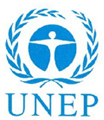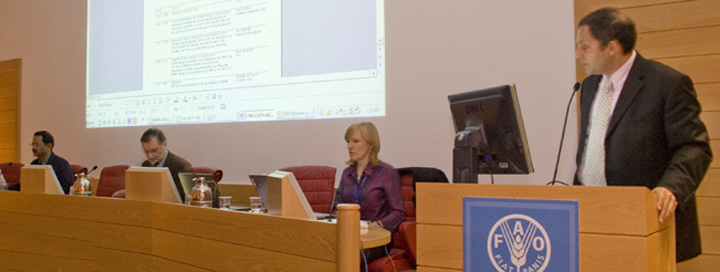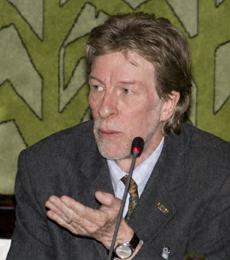




Wildlife disease: A cross-cutting issue for the conservation of migratory species
Presented by the Scientific Task Force on Avian Influenza and Wild Birds
Ruth Cromie, Wildfowl and Wetlands Trust, outlined why wildlife disease is a concern for the health of domestic animals and humans. She said diseases should be seen in an ecological context as a natural part of the ecosystem and outlined its impacts at the individual level, including leading to mortality, reducing competitive fitness, increasing susceptibility to predation and reducing fecundity. Cromie stated that progress has been made towards providing guidance and practical management measures for government agencies and conservation managers. She concluded that wildlife diseases are a major cross-cutting subject and stressed that the ability to monitor and manage wildlife disease remains relatively poor. Cromie highlighted the multidisciplinary nature of the problem and the need for integrated solutions.
Taej Mundkur, Wetlands International, stressed the impacts of Avian Influenza (AI) on domestic poultry, livelihoods and biodiversity. He noted the declining public support for bird and habitat conservation due to misleading messages regarding diseases, which has fueled calls for culling of wild birds and reduced the number of visitors to nature conservation areas. Mundkur noted the importance of building cross-sector cooperation with NGOs, technical institutions, and international and local organizations to study and control AI. He explained that the Scientific Task Force on AI and Wild Birds was established in 2005 aiming at, inter alia: providing sound guidance for wildlife experts, scientists, decision makers and the media; ensuring that internal efforts do not overlook vital information concerning migratory species; and finding ways to apply the findings to other diseases. Mundkur noted the success story of global collaboration to combat the AI.
Scott Newman, FAO, explained that global activities for addressing aspects of wildlife diseases include: building awareness, modifying activities of international organizations, establishing international treaties, sharing databases and data, and increasing capacity building activities. He drew attention to the concept of “one world, one health” and explained its general principle of the need to have ecological health that ensures the health of wildlife, humans and domestic animals. Newman outlined the activities developed by the Scientific Task Force on AI and Wild Birds in collecting and disseminating scientific information on AI and wild birds. He said prevention is a better way to deal with diseases and to respond to emergencies.
Ruth Cromie <ruth.cromie@wwt.org.uk>
Taej Mundkur <taej.mundkur@wetlands.org>
Scott Newman <scott.newman@fao.org>
Measuring Progress: The 2010 Biodiversity Indicators Partnership, the 2010 Target and their applicability to the CMS and its parties
Presented by 2010 Biodiversity Indicators Partnership
Damon Stanwell-Smith, UNEP-WCMC and the 2010 BIP Project Co-ordinator, outlined the history of the BIP and the project’s focal areas, noting that suitable indicators have yet to be developed for the access and benefit-sharing focal area. He said the BIP partners prepare reports every six months until 2010, and the project outputs will include the publication of the third Global Biodiversity Outlook (GBO3) in 2010 and the sharing of experiences and lessons learned across the scales.
Rob Clay, BirdLife International, discussed the IUCN’s Red List index, which he said is widely recognized as the most objective system of classifying species in terms of their risk of extinction. He presented the continuum that ranges from species of least concern to those that are extinct, noting that measurement assumes that no additional conservation measures beyond those currently in place are undertaken.
Julia Latham, Zoological Society of London, described the Living Planet Index (LPI), which was adopted by the CBD, and is a measure of the abundance and trends of vertebrate species using population time series data from 1970. She said the LPI database includes 803 migratory species, approximately half of which are listed on the CMS appendices, and with examples, demonstrated how the indicators can be applied to the CMS and its other agreements. Latham said the LPI is sensitive to change, its results are scalable and easy to communicate, despite the complex science behind it, and that it can provide early-warning services.
James Williams, Joint Nature Conservation Committee, UK, presented on the country’s experience in applying the CBD indicators. He said 18 indicators are used, with data drawn from existing sources, with a view to determine whether the country is moving in the right direction. He noted progress is based on changes since 2000, the year in which the BIP was adopted. He emphasized the need to use a “basketful of indicators” and to use the results for communicating to the public and policy makers.
In the discussion, participants highlighted that some indicators of the BPI’s focal areas are still under development and would not be ready until 2010, and noted the need to consider the future work on the CBD indicators and the BIP project post-2010. On the development of indicators for access and benefit-sharing, participants acknowledged that: little progress has been made; consideration is being given to the use of patent information for measurement; and partnerships with organizations such as OXFAM that measure social and biodiversity issues need to be considered. Participants noted that a key challenge is how to reconcile the conflicting schedule of preparing the 2010 GBO3, which will use data that are currently being generated, and the CBD’s 2010 timeline, whose results would only be published in 2011.
http://www.ramsar.org
http://www.unep-wcmc.org/
http://www.birdlife.org/
http://www.zsl.org/
http://www.jncc.gov.uk/biyp/
Damon Stanwell-Smith <damon.stanwell-smith@unep-wcmc.org>
Rob Clay <rob.clay@birdlife.org>
Julia Latham <Julia.latham@ioz.ac.uk>
James Williams <james.williams@jncc.gov.uk>
UNEP/CMS Thesis Award on Migratory Species Conservation
Presented by Friends of CMS
Samantha Petersen, 2008 Thesis Award Winner, summarized her thesis and explained that it focuses on the by-catch of seabirds, turtles and sharks in fishing operations, in particular long-line and trawl fisheries, which have been widely held responsible for their declining populations and threatened conservation status. She highlighted similarities among the species that include long periods of breeding, limited ability to recover, their migratory nature and the fact that they live in small populations. Petersen said the study proposes measures to ensure seabirds are not caught, and emphasized the implementation of regulations to prevent the annual killing of 20,000 seabirds.
Lutz Laemmerhold, Deutsche Lufthansa, on behalf of the award sponsors, National Geographic and Museum Koenig, highlighted the importance of the award in communicating to, and mobilizing the support of, the public in CMS’ work and promoting scientific expedition. He expressed Lufthansa’s commitment to work supporting the environment, and emphasized that the protection of biodiversity is important to human survival. Laemmerhold noted that this was the second such award, and said the large number of applications demonstrated the dedication of young scientists to the conservation of endangered species. He said if the award continues to help young scientists to participate in CMS work, the sponsors will continue to support the award and assist in raising awareness on the species covered by CMS. Laemmerhold then presented the award to Petersen.
Manfred Niekisch, Frankfurt Zoologischer Garten and Chair of Friends of CMS, highlighted the importance of gathering efforts to assist in implementing the Gorillas Action Plans under the CMS Gorilla Agreement. He said his organization selects projects on migratory species that are supported by CMS. Niekisch said that Friends of CMS are working to raise more funds to implement CMS decisions and promote the work of CMS.
http://www.wwf.org.za
http://www.unep.org
http://www.lufthansa.de
http://www.nationalgeographic.de
http://www.museumkoenig.de
Samantha Peterson <spetersen@wwf.org.za>
Lutz Laemmerhold <lutz.laemmerhold@dlh.de>
Manfred Niekisch <manfred.niekisch@stadt-frankfurt.de>








